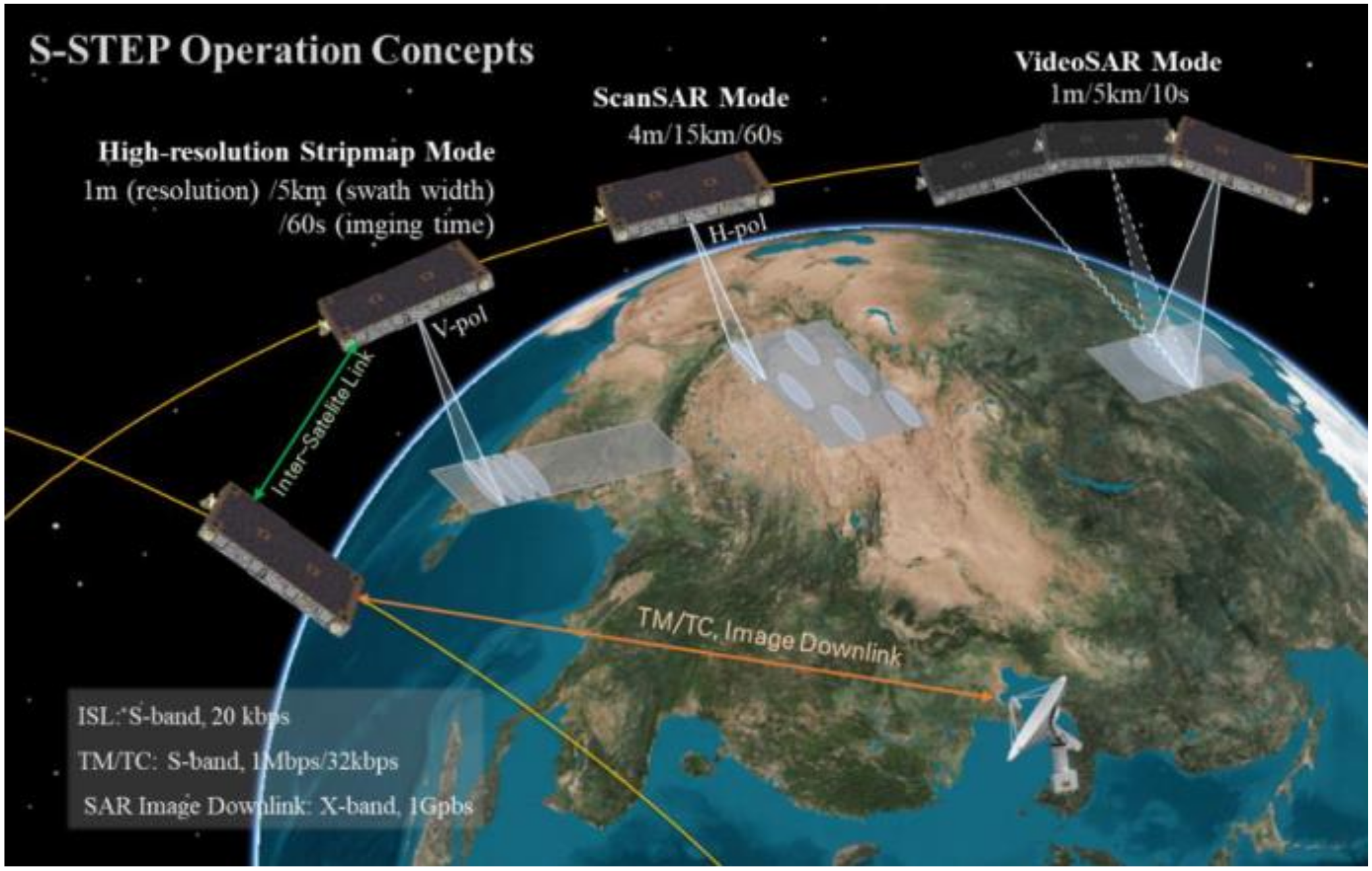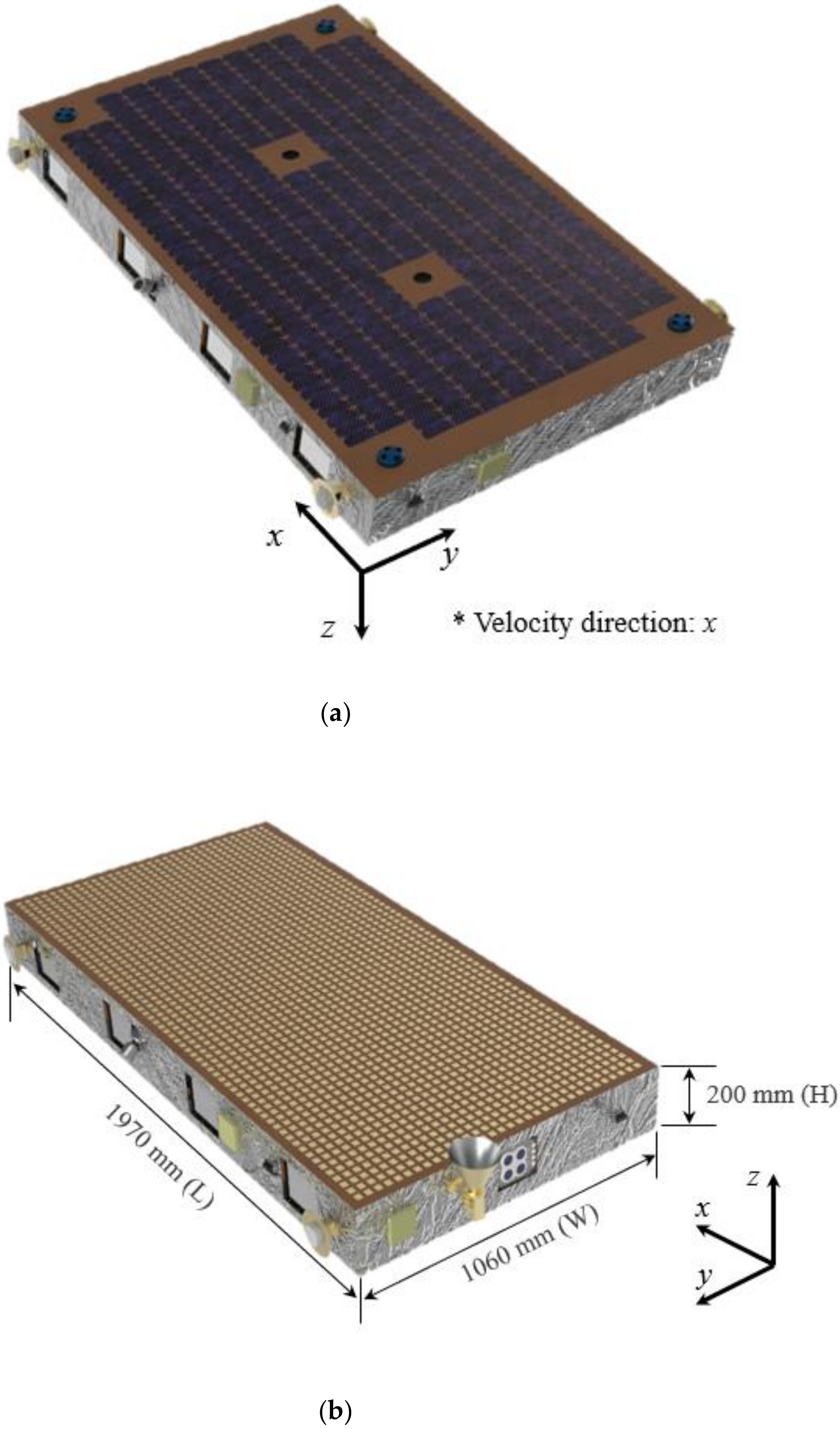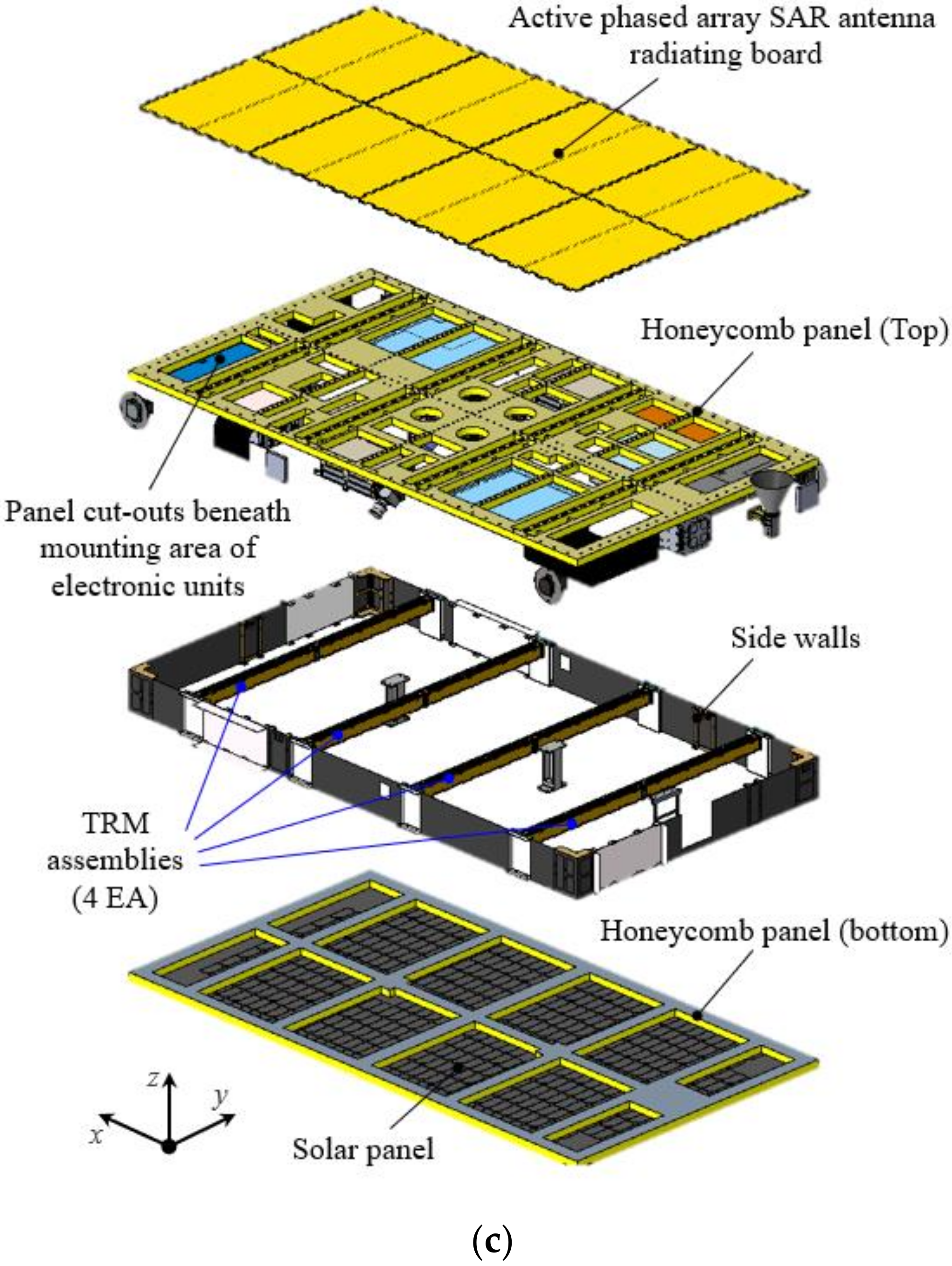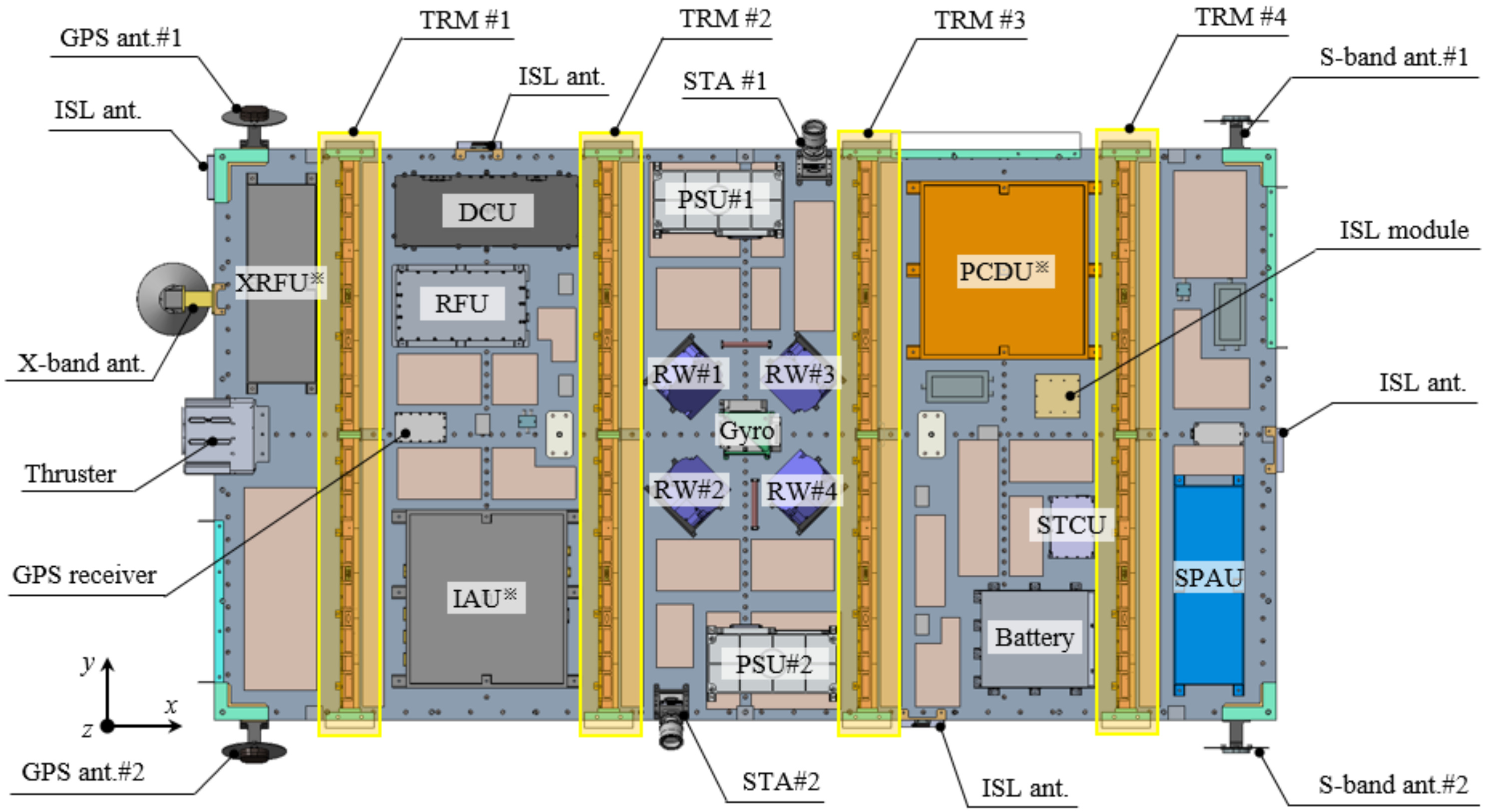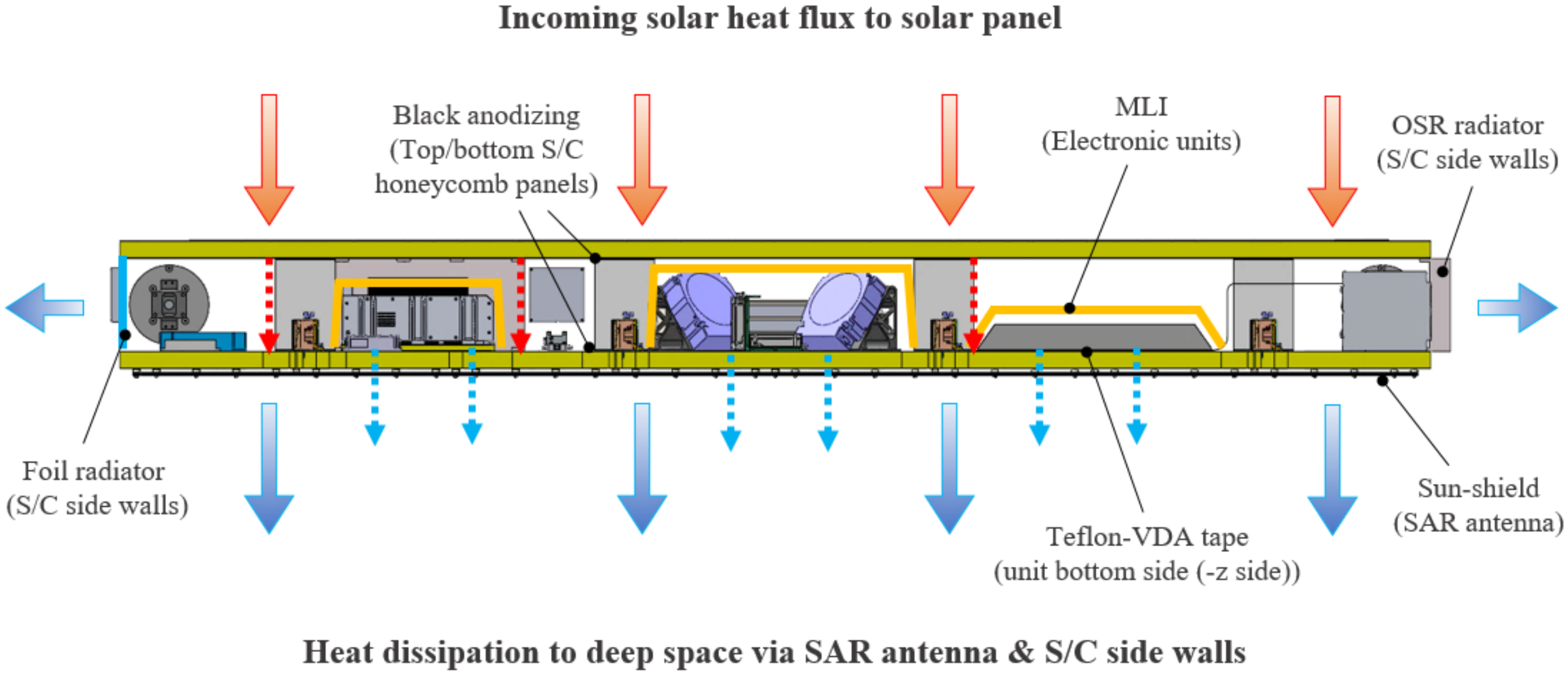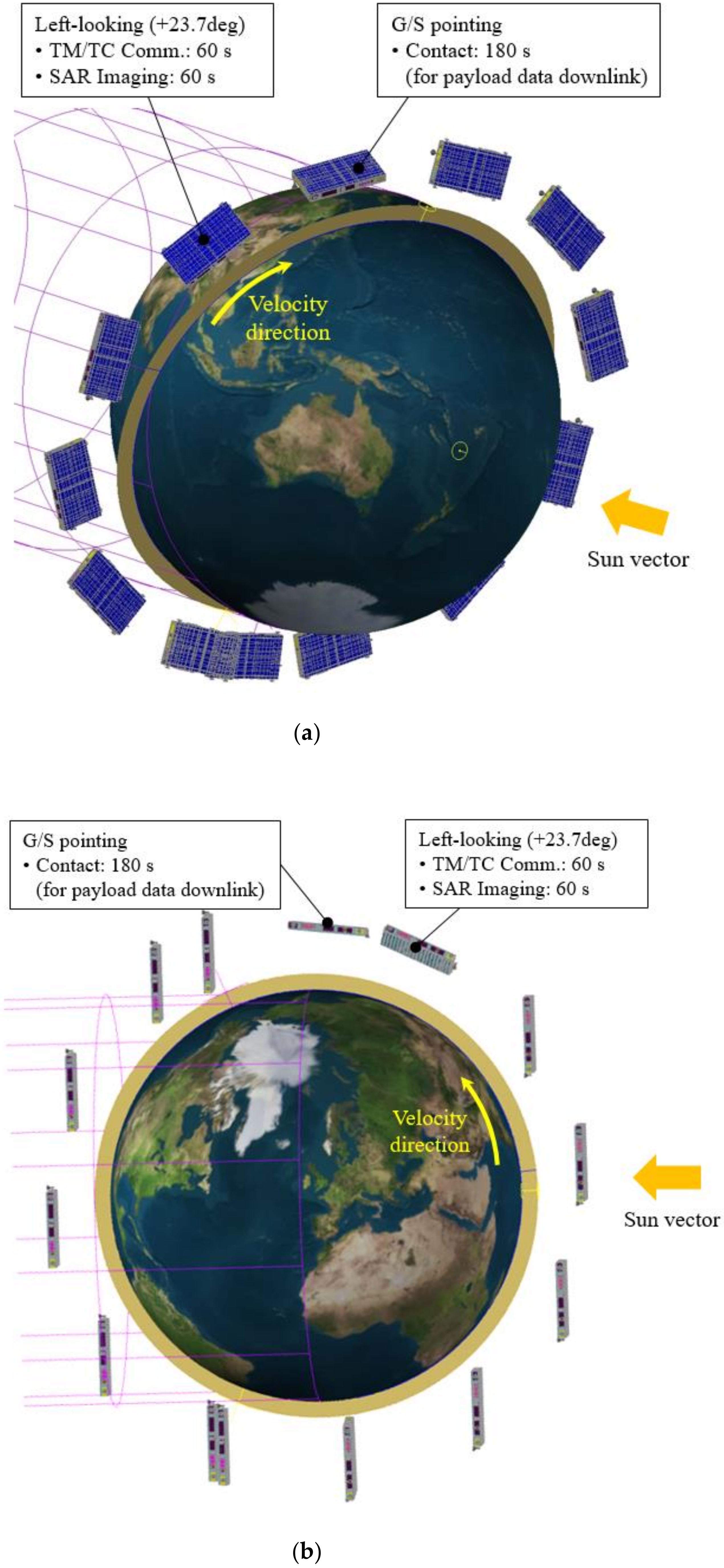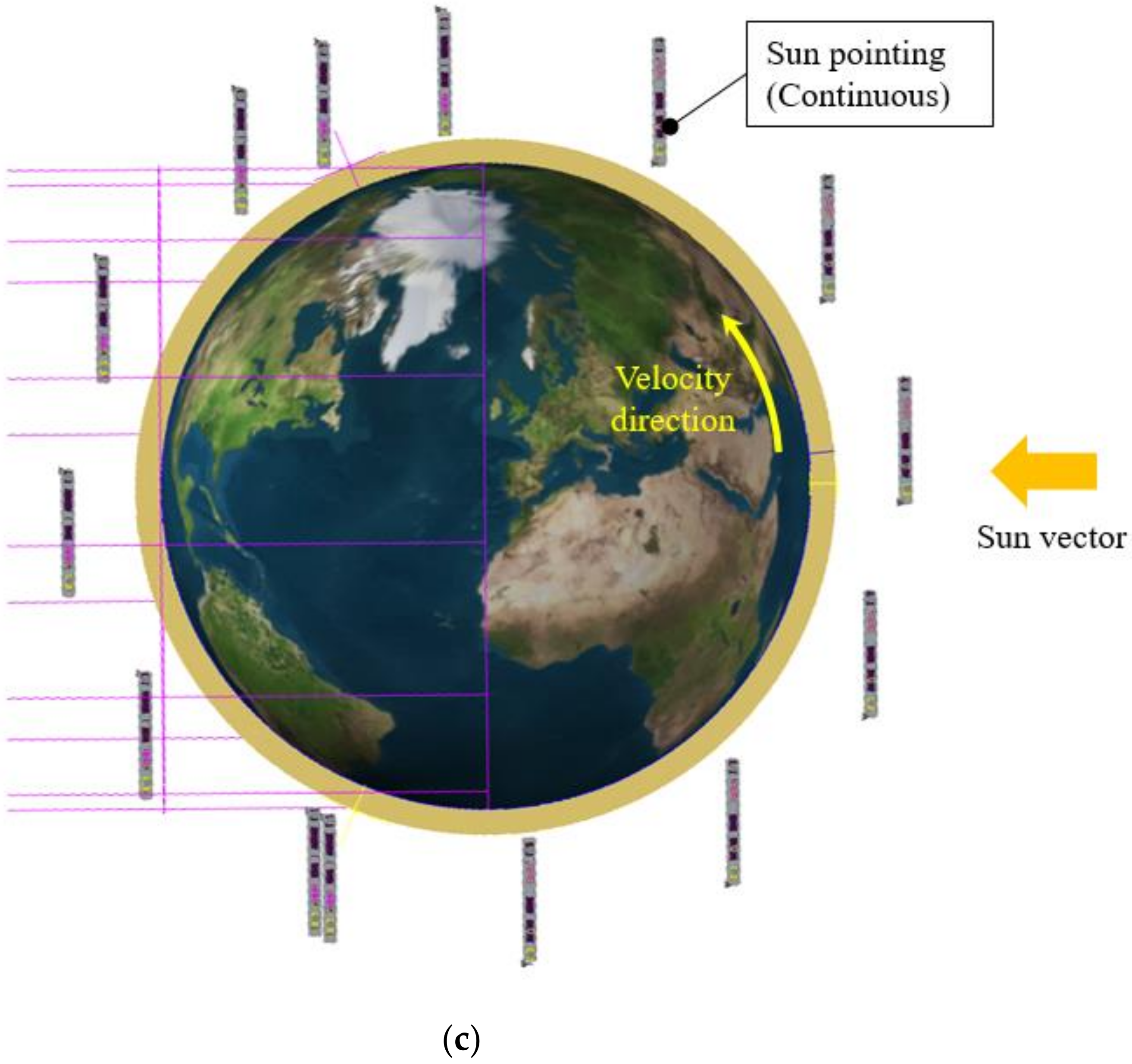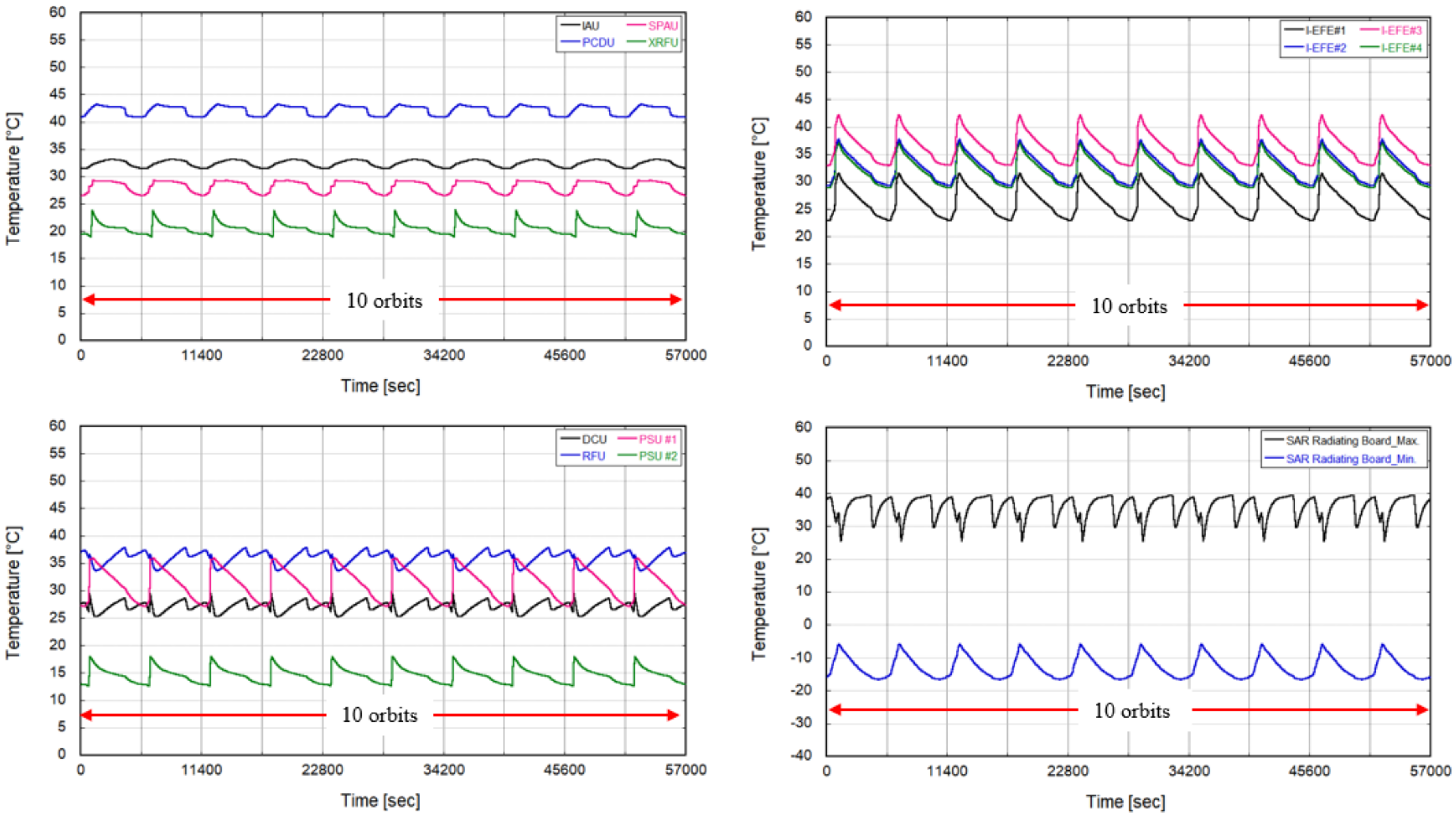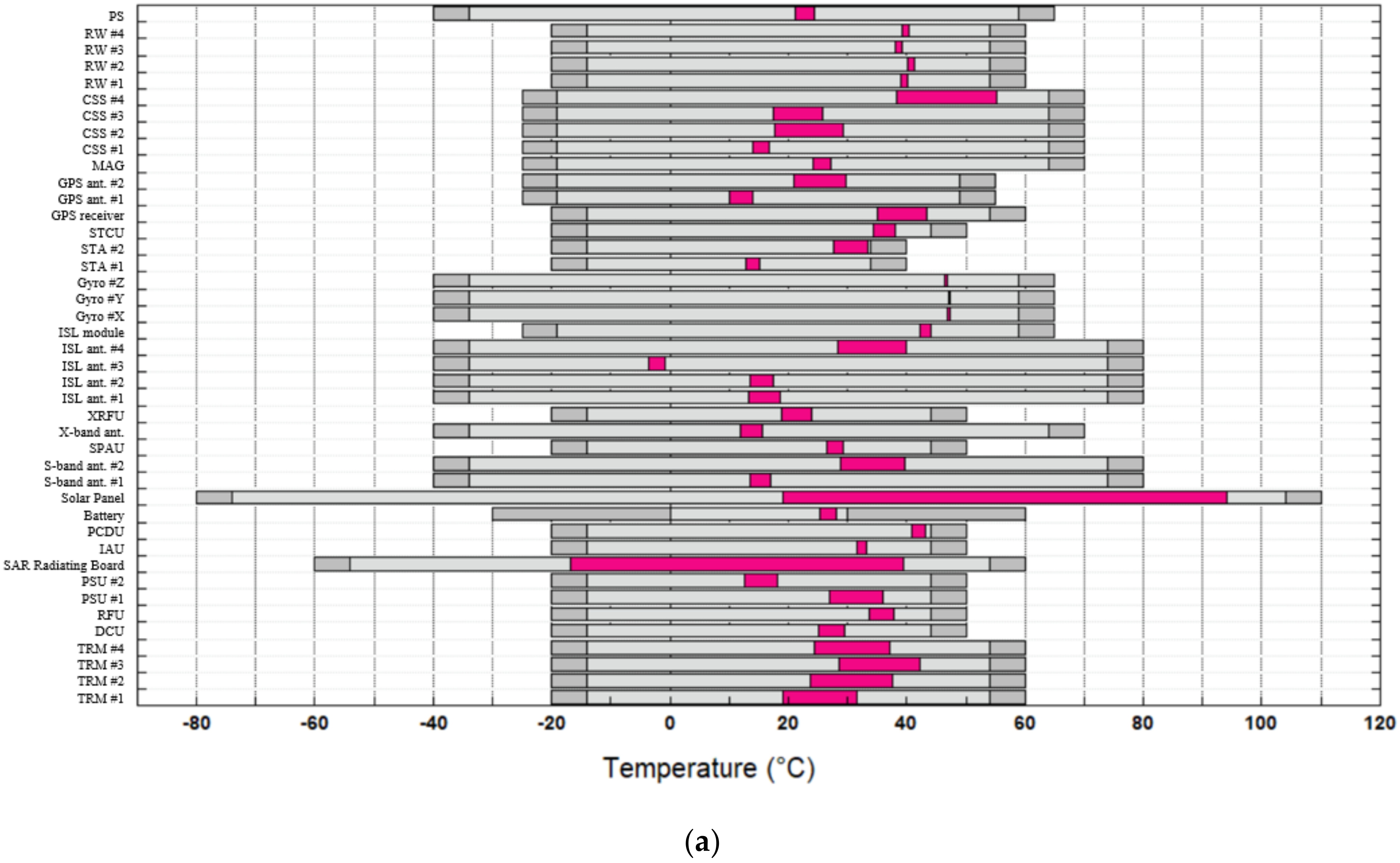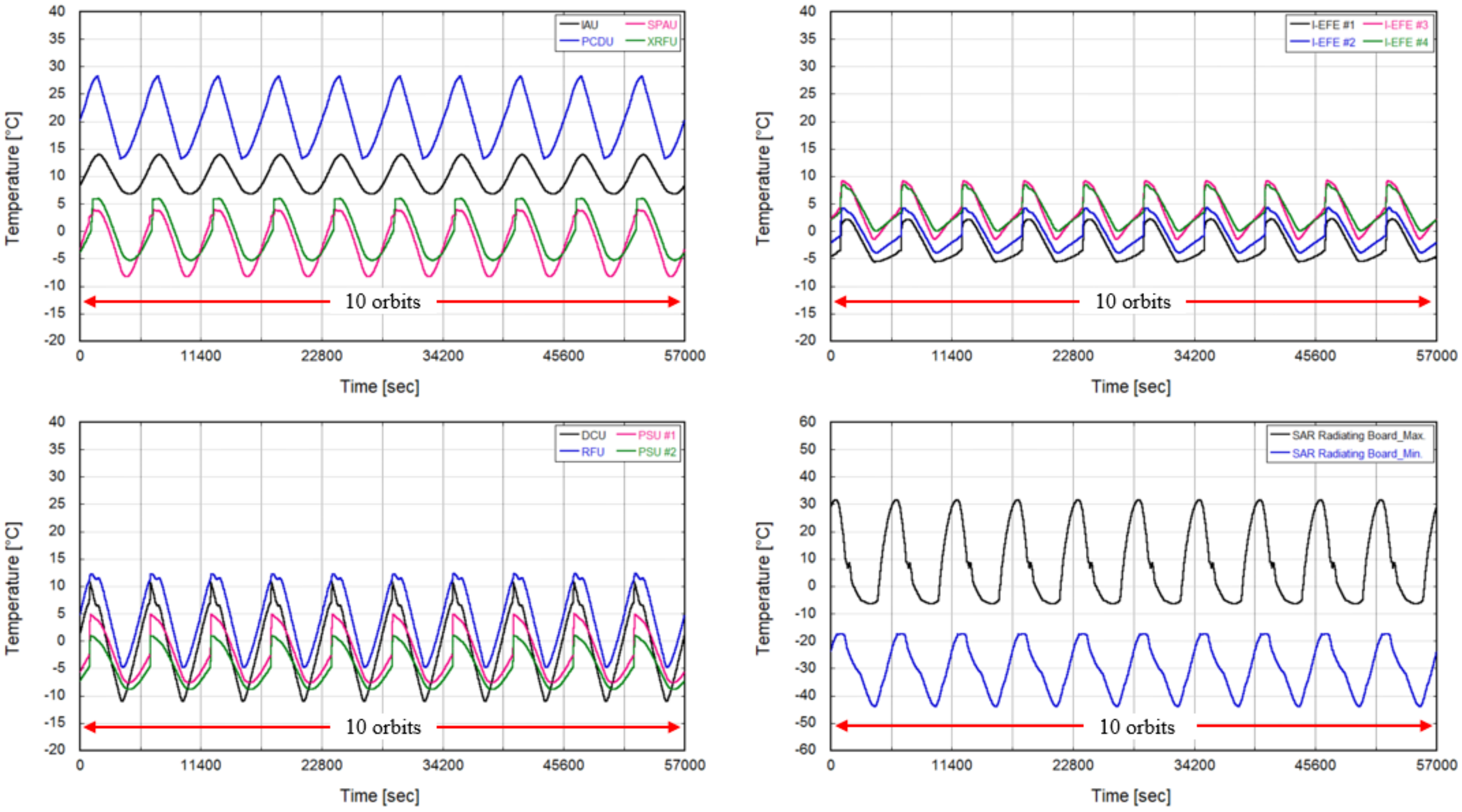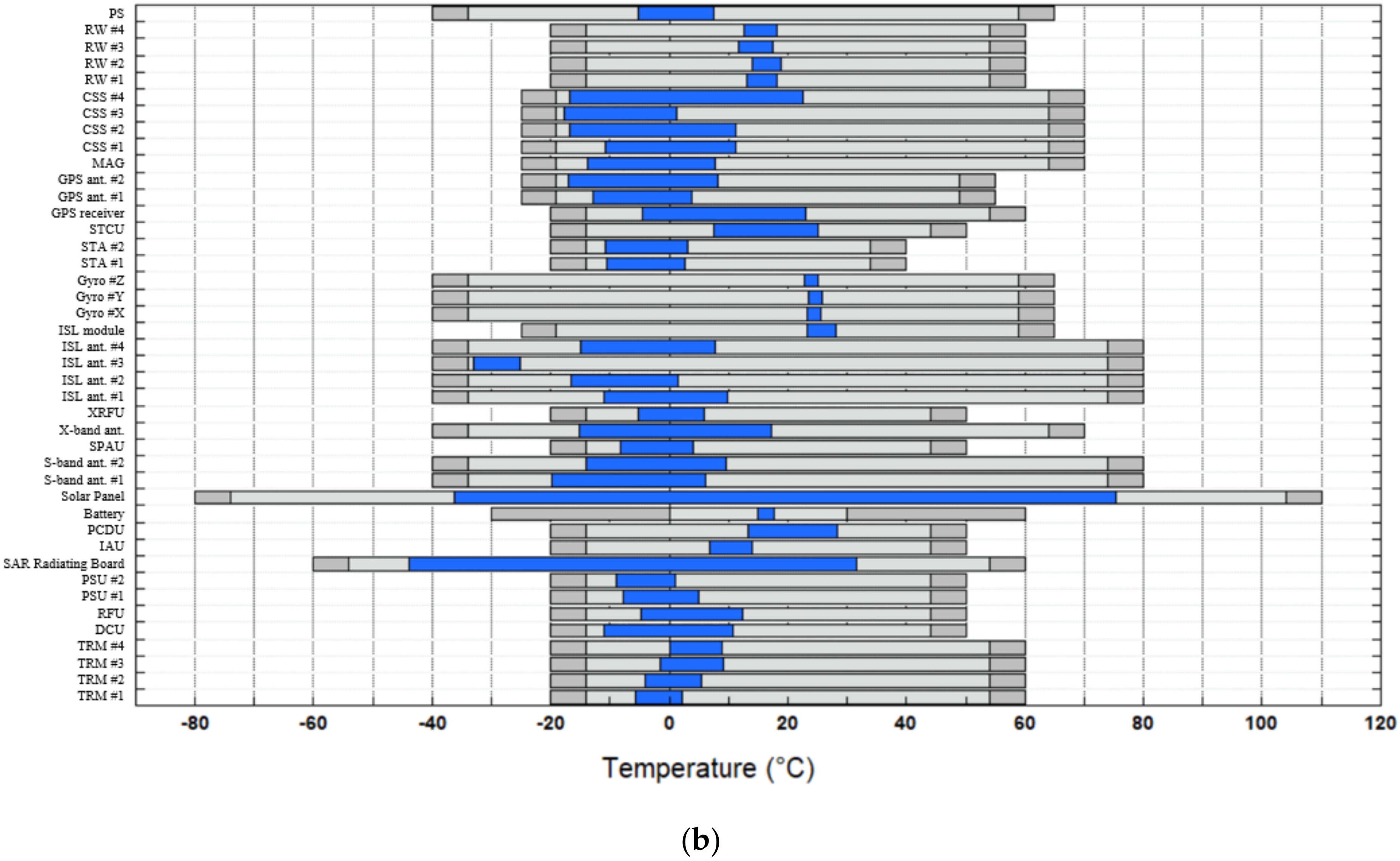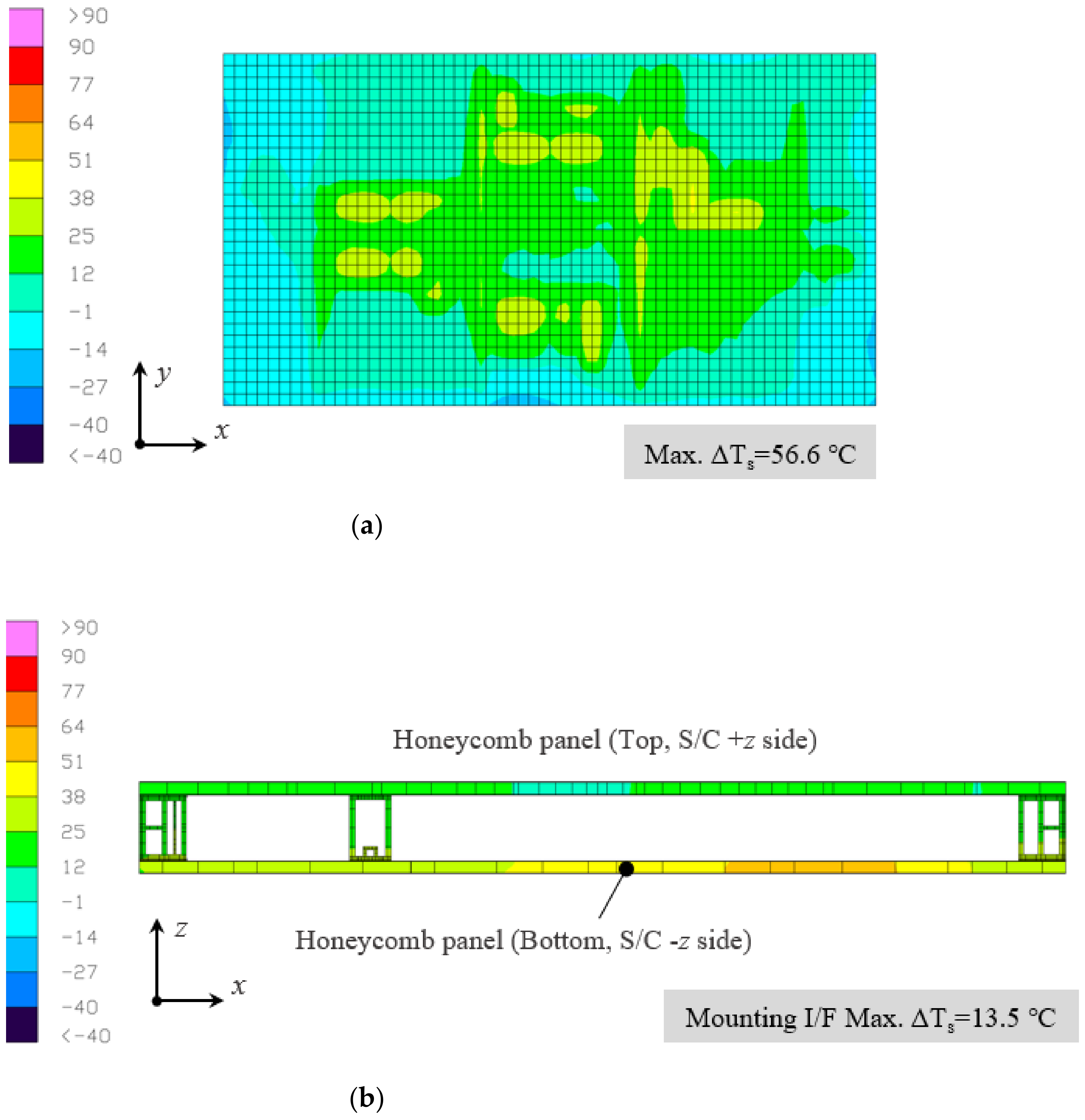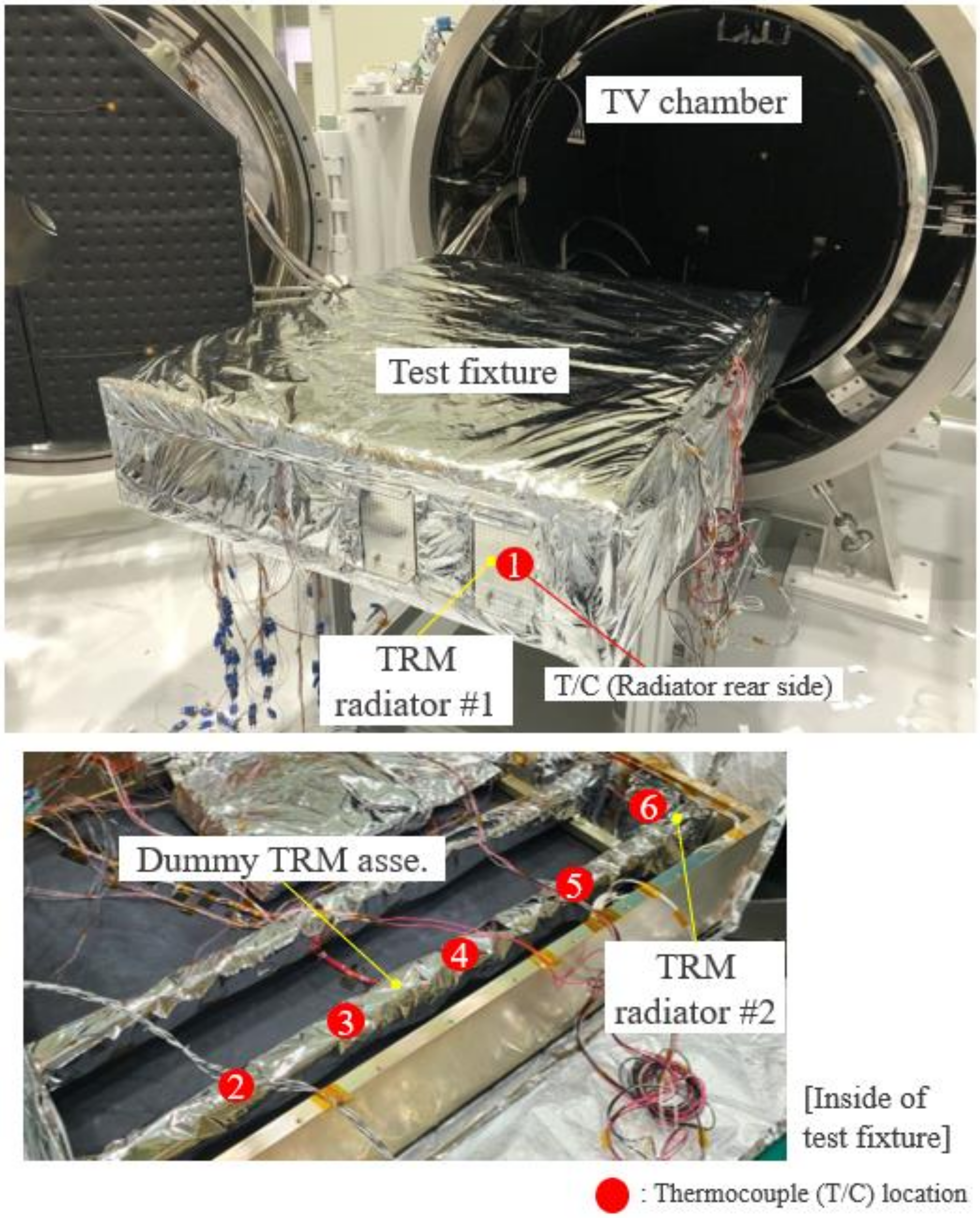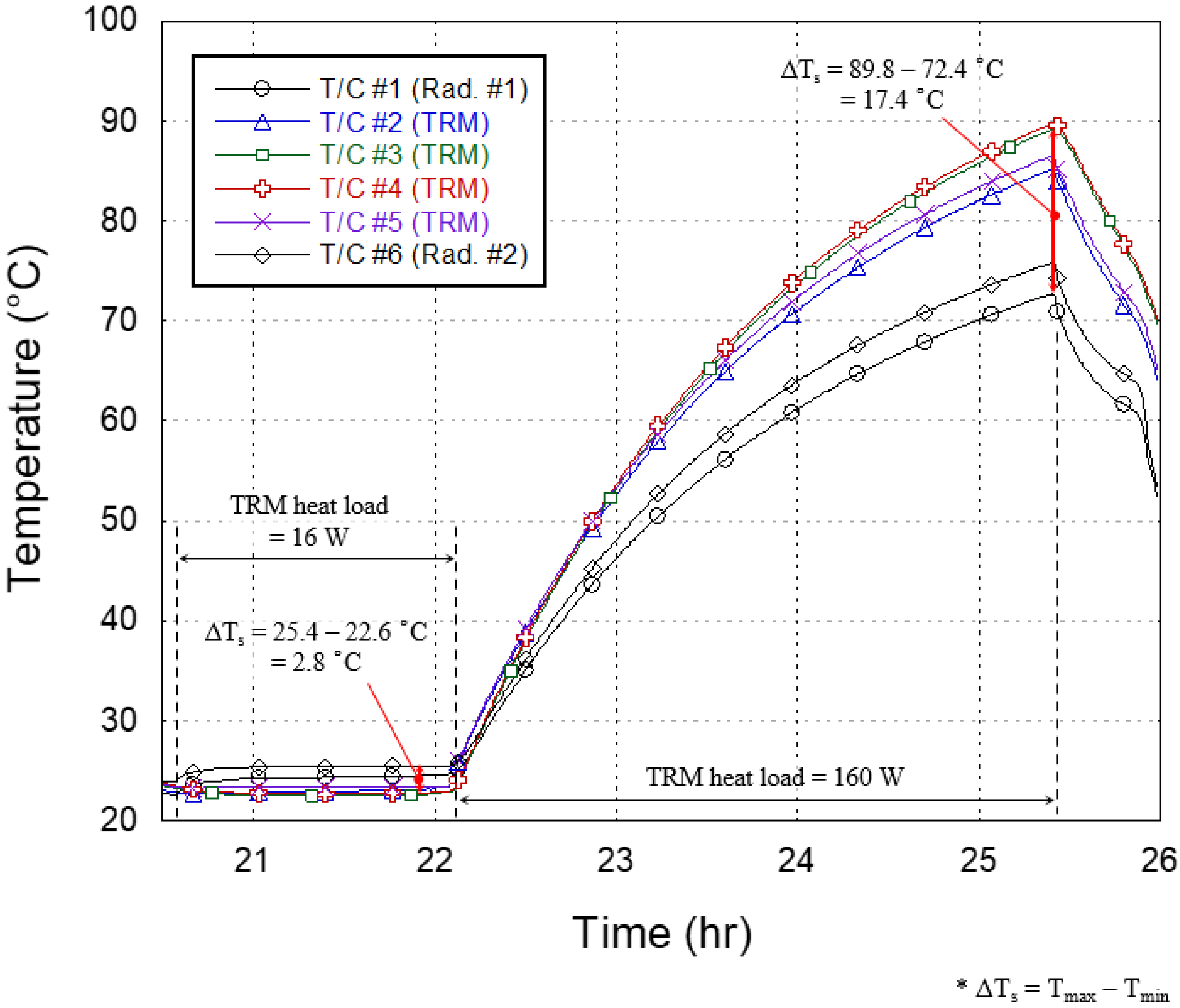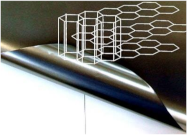1. Introduction
The so-called NewSpace paradigm refers to the recent commercialization of the space sector. The technology innovations of satellite and launch vehicles, as well as various relevant services, are now leading the rapid advances and growth of global space industries [
1]. One of the technologies that plays an important role in the NewSpace era is the emergence of a small satellite constellation. The constellation of multiple satellites effectively reduces the system’s temporal performances, such as revisit and response time, which enables frequent access to the target. The smaller, lighter, faster, better, and cheaper small satellite platform realized a large-scale constellation in orbit based on satellite mass production, which was nearly impossible with large-scale satellites [
2]. The reduction of satellite launch cost, via reusable launch vehicles, small-scale launchers, and air-launch-to-orbit, have increased the satellite launch capability, thus contributing to the rapid orbital insertion of small satellites. These advantages make the small satellite platform attractive for implementing various low earth orbit (LEO) constellation missions, such as near real-time earth observation, global internet services, and communication networks, for commercial and military purposes [
3,
4,
5].
The concept of a synthetic aperture radar (SAR), proposed in the 1960s, significantly changed the field of spaceborne remote sensing [
6]. Its advantage compared with traditional optical imaging is the ability to obtain high-quality images, even when the target area is in nighttime or covered with obstacles, such as cloud and fog. Owing to this imaging capability, the demand for SAR imagery in space has rapidly increased in various sectors, including government, military, and commercial sectors [
7]. The constellation of small satellites with SAR instruments is a solution to meet the increasing demands. To date, many small SAR satellites, such as ICEYE X2, Capella X-SAR, StriX, and QPS-SAR, have been developed and launched by industries globally. They are in-orbital operations to provide SAR images at a 1 m class resolution [
8,
9,
10,
11]. To meet the various mission needs on spaceborne SAR imagery, the demand for an active phase array-type SAR antenna has been increasing for small satellite applications, as its electronic beam steering capability provides various SAR imaging modes, including stripmap, spotlight, and ScanSAR.
Proper thermal control is crucial to guarantee the functionality and thermo-mechanical stability of an SAR satellite with many high-power instruments in extreme on-orbit thermal environments. Traditionally, most SAR satellites have adopted flexible deployable SAR antenna panel structures [
12] to achieve the desired SAR imaging performance. Thermal designs for SAR satellites have been mostly based on passive thermal control approaches using suitable thermal coatings, paints, thermal fillers, thermal insulators, radiators, multilayer insulation (MLI), and sun-shield. In addition, heat pipes and doublers have been applied to the radiator for effective heat dissipation of some high-power instruments, such as transmit/receive modules (TRMs) and electronics. The heat loss through the radiator was compensated by a heater. To date, several studies [
13,
14,
15] have proposed and investigated the thermal design for SAR satellites based on thermal control hardware.
In addition to the small SAR satellites, Yang et al. [
16] proposed a quasi-all-passive thermal control system (TCS) design for the Luojia 1-01 satellite with the problems of low thermal inertia and poor thermal conductivity of the satellite structure. They adopted surface coatings, thermal interface materials, MLI, and active heater control to achieve the minimum system mass and power budgets. Yendler et al. [
17] proposed the thermal management system (TMS), which is capable of rejecting 1 kW of waste heat produced in the satellite. The TMS mainly consisted of rollout-type flexible deployable radiator, heat pipes integrated with the satellite structure, and phase change material with high heat storage capacity. They applied TMS to the 12U-class CubeSat and verified its effectiveness through the numerical thermal analysis. Ueno et al. [
18] proposed functional thermal control systems for 100 W-class high-power 3U CubeSat. They used a heat storage panel with pitch type CFRP, micro loop heat pipe, and flexible re-deployable radiator. The effectiveness of adopting those thermal hardwares was numerically and experimentally verified. In all, a considerable number of previous studies reported thermal designs for small satellites [
16,
17,
18,
19,
20,
21].
For small SAR satellites, the light weight and compactness of onboard instruments are essential factors due to the limited mass and volume of satellite platforms. For a small satellite constellation mission, these factors would be far more essential because they are directly related to the available number of satellites launched at once. Currently, the adoption of the abovementioned passive thermal hardware might be the most suitable solution for the thermal control of small SAR satellites; however, the thermal design of small SAR satellites needs to be optimized for minimizing system mass and power budget allocated for a thermal control subsystem. In addition, it is necessary to minimize the heater’s power consumption to achieve the compactness of the satellite by solar panel and battery size reduction.
An 80 kg class high-resolution earth observation small satellite with X-band active phase array SAR, named the Small SAR Technology Experimental Project (S-STEP) [
22], is under development. For developing an S-STEP system in accordance with a smaller, lighter, faster, better, and cheaper NewSpace paradigm, several mechanical design strategies are being adopted for the satellite [
22]. The design strategies involve a bus–payload integrated flat panel-type satellite platform, a multifunctional TRM structure, and a vibration-free orbital deployer (VFOD). The flat panel-type satellite structure does not require flexible deployable structures, and it could be beneficial in terms of the dimensional stability of SAR antenna in extreme on-orbit thermal environments. The TRM assembly of S-STEP functions as a structural stiffener for the satellite structure and provides thermal dissipation through a radiator integrated with TRM. Thus, it can minimize the application of additional stiffener for the structural reinforcement of the satellite. These strategies make it possible to minimize the system mass budget while ensuring the structural safety of vibration-sensitive onboard instruments under launch loads. In particular, the structural design load reduction achieved by VFOD contributes to minimizing the development period and cost by optimizing the verification test process, i.e., streamlining and skipping the test phase or a step at a subsystem level can be positively considered. These advantages make it attractive to be used for implementing the NewSpace small SAR satellite. The effectiveness of these mechanical design strategies has been investigated by Kwon et al. [
22]. However, this study did not perform the numerical or experimental verification of those thermal designs. To date, no other previous studies addressed the thermal design strategy for this form of small SAR satellite. In particular, no previous study qualitatively verified the thermal design to achieve the designated SAR imaging duration in both left- and right-looking modes of the small SAR satellite, although it is one of the most important system performance factors.
This study proposes a new thermal design strategy for assuring the functionality and thermal stability of the S-STEP system in an on-orbit thermal environment. The payload–bus integrated flat panel-type unique mechanical design of S-STEP requires efficient thermal control to achieve an SAR imaging duration of 60 s in both left- and right-looking modes and keep all onboard components within allowable temperature thresholds in orbit. For lighter, smaller, better, and cheaper development of the S-STEP system, the proposed thermal design strategy is based on the optimization of environmental heat fluxes acting on the satellite by passive thermal control using surface coatings, MLI, and radiators. In addition, a lightweight flexible graphite sheet with high thermal conductivity is used as conductive thermal paths between some high-power instruments and dedicated radiators. The multifunctional structure of TRM assembly provides effective thermal dissipation capability through the integrated radiators during SAR imaging. These strategies contribute to minimizing the satellite mass budget and heater power consumption, which help realize the implementation of a “lighter” SAR satellite. To verify the effectiveness of the proposed thermal design strategy, an on-orbit thermal analysis of the S-STEP system was performed. Further, the effectiveness of thermal design on the key payload components and multifunctional TRM structure was experimentally evaluated in a space-simulated thermal vacuum environment.
2. S-STEP System Overview
The S-STEP program has been started to develop an 80 kg class lightweight small SAR satellite for high-resolution SAR imagery for environmental investigation, surface mapping, and disaster monitoring. The mission operation concept of the S-STEP system is shown in
Figure 1 [
22]. The S-STEP system is operated at LEO and provides a 1 m resolution stripmap image, 4 m resolution ScanSAR image, and 1 m resolution VideoSAR for 10 s duration to capture the earth’s targets of interest. The SAR payload of S-STEP is an aperture-coupled cavity-backed microstrip patch array antenna, which can achieve high radio frequency (RF) gain. A total of 192 TRMs were applied to implement electronic beam steering capability in the elevation direction of the antenna. The SAR image data are transferred to an integrated avionics unit (IAU) for storage. The stored data are transmitted to the ground station through a 1 Gbps X-band downlink module. The expected mission lifetime of the S-STEP system is 3 years. The S-STEP program ultimately aims to implement a satellite constellation for near real-time SAR observation. Therefore, the S-band inter-satellite link (ISL) system is considered for immediate communication link between the satellites.
Table 1 lists the basic system specifications of S-STEP [
22].
Figure 2 shows the mechanical configurations of the S-STEP satellite. The primary feature of its mechanical design is the bus–payload integrated flat panel-shaped satellite structure. This mechanical configuration is advantageous to ensuring the dimensional stability of the satellite, especially the SAR antenna, in extreme on-orbit thermal environments. One more essential feature of this satellite configuration is the additional 0 g compensation device for on-ground testing of SAR antennas, as it is a nondeployable-type antenna. All payload and bus electronic units are mounted on the top aluminum-skin honeycomb composite panel as the configuration shows in
Figure 2c and
Figure 3. Four reaction wheels (RWs) in a pyramidal configuration with an optimal tilt angle are mounted at the center of the satellite to minimize the moment of inertia and their power consumption. The X-band antenna for payload data downlink and two S-band antennas for telecommand/telemetry (TM/TC) communication are installed on the side walls in −
x, +
y, and −
y sides of the satellite. The GPS and ISL antennas are also installed on various locations of the side walls. To operate the satellite, 340 W of electrical power is produced at beginning of life (BoL) and stores the power in the battery with 648 Wh capacity. Among the on-board instruments of satellite, the four TRM assemblies require the largest amount of power consumption. In the SAR imaging operation, the stored battery power is mainly used to operate these TRM assemblies.
The satellite is integrated on a VFOD introduced in a previous study [
22], which has the dual functions of the orbital insertion of satellite and the entire spacecraft vibration isolation. The main function of VFOD is an on-orbit satellite separation combined with a side-mounting ride-share platform. The additional function of launch vibration isolation was a key factor in minimizing the satellite mass, as the structural reinforcement was reduced by launch load mitigation. The multifunctional structure of payload components, the adoption of a new structural design methodology called Oh-Park methodology [
23] for spaceborne electronics, and the proposed thermal design strategy contributed to further satellite mass reduction. The mass of the satellite was 80.3 kg due to these mechanical design strategies. A previous study [
22] showed that the SAR performance index with respect to the satellite mass was close to those of the other small SAR satellites developed in accordance with the NewSpace paradigm. This study verified the feasibility of the proposed mechanical design strategies for S-STEP through satellite system-level structural analysis.
3. New Thermal Design Strategy for S-STEP
The primary objective of establishing a new thermal design for S-STEP is to ensure long-term high-resolution SAR imaging duration for 60 s regardless of the right- and left-looking modes of an SAR antenna. In addition, the thermal design shall maintain all onboard components within their allowable temperature limits (
Table 2) in extreme on-orbit thermal environments with minimal use of heater power. To accomplish the thermal design objectives, the heat of the high-power components, such as the TRM assemblies, power conditioning and distribution unit (PCDU), IAU, and battery, shall be effectively dissipated to the outer space. These are the main focuses of the proposed thermal design. To implement a “lighter” satellite, the thermal design is mainly based on passive thermal control approaches using surface coatings, MLI, and heat dissipation radiators. The use of thermal hardware that occupy some portion of the mass to some extent, such as heat pipe and doubler used conventionally [
13], are avoided for S-STEP.
Figure 4 shows the new thermal design concept for the proposed S-STEP system. The front SAR antenna surface (−
z side) and side walls (
x and
y sides) are exposed to relatively lower environmental fluxes. Therefore, these surfaces can be used for dissipating satellite internal heat to outer space. Moreover, the incoming solar heat flux on the solar panel (+
z side) can be used as a heat source to compensate for heat loss. The optimization of solar heat flux and heat dissipation of the satellite is achieved by applying various thermal coatings, MLIs, and radiators to control the heat exchange between structural elements and components, which results in minimizing the heater power budget, contributing to further satellite mass reduction due to decreases in solar panel and battery sizes. This thermal design concept is the most innovative and unique aspect of the proposed thermal design strategy for S-STEP that has never been attempted in the previous small SAR satellite programs.
In the thermal design, an RF-transparent sunshield covers the external side of the SAR antenna for heat rejection. The primary satellite structures of aluminum-skin honeycomb panels are black anodized for minimizing the thermal gradient over the entire satellite structure by facilitating the internal heat exchange. The internal waste heats of payload and bus electronic units and solar panels are dissipated via mounting surfaces (−
z side) to the SAR antenna. Thus, most honeycomb panel areas, including the mounting areas for electronic units, were cut-out for their effective heat dissipation (
Figure 2c). These cut-outs were advantageous to reduce the satellite mass as well. The electronic unit mounting surfaces (+
z side) were coated with Teflon-VDA tape with high emissivity. The rest of their surfaces were covered with MLI to avoid the absorption of heat radiated from the solar panel. For further heat dissipation, second surface mirror (SSM) foil radiators were integrated on the sidewalls (
Figure 5).
For effective heat dissipation of PCDU, IAU, and battery producing relatively larger amount of waste heat than the others, this study focused on the unique characteristics of a lightweight flexible graphite sheet. The graphite sheet is a popular thermal interface material and has been used in various fields, such as portable devices, electronics, and space engineering [
24]. It has many advantages, such as high thermal conductivity in the in-plane direction of the sheet (four times higher than copper), light weight, flexibility to bending, high heat-resistance, and availability to use in a vacuum. All these characteristics make the graphite sheet attractive to use for thermal control of small satellites with a limited mass budget.
Table 3 lists the specifications of the graphite sheet used for the S-STEP satellite. In the S-STEP thermal design, the graphite sheet was used to form the heat transfer paths from the IAU, PCDU, and battery to the dedicated radiators, respectively (
Figure 6 and
Figure 7a). Both ends of the graphite sheet were clamped on the unit and radiator, respectively, to implement a secure thermal contact. For PCDU, where a larger amount of heat rejection is required than others, two radiator assemblies with graphite sheets were applied to the unit. The thermal control solution using a graphite sheet could be more advantageous than the conventional heat pipe in terms of light weight and unnecessity to maintain the orientation to the horizontal plane of the pipe to avoid the gravitational effect during an on-ground test. A total of 15 graphite sheet layers, determined on the basis of a previous study [
25], were applied with respect to each component.
In the thermal design, the battery module is the only component requiring heater control for temperature management to maintain the electrical power storage capacity. This fact indicates that the power budget-saving can be expected based on the proposed thermal design strategy. A Kapton polyimide film heater was attached adjacent to the battery radiator. Through the preliminary thermal analysis, the on/off set-points of the heater are set as 15/16 °C, and the heater power was determined as 30 W to satisfy the requirement of heater duty to be lower than 80%.
The effective heat dissipation of TRM is a crucial factor in achieving the long-term SAR imaging duration of 60 s in both left- and right-looking modes of SAR antenna in orbit. In the previous study [
22], the concept of the multifunctional TRM assembly structure was introduced as the configuration shown in
Figure 6. A single TRM assembly was integrated with two optical solar reflector (OSR) radiators at both ends to effectively dissipate the heat produced during SAR imaging operation (
Figure 7b). In this study, the U-shaped configuration of each radiator further enhanced the heat dissipation capability by increasing the radiating area. In addition, the proposed design was intended to dissipate heat to the bent parts of the radiator, even if the incidence angle of heat flux varied with the attitude maneuvering of the satellite. The radiator design also provided mechanical interfaces to integrate the top and bottom honeycomb panels of the satellite. To minimize the thermal gradient over the TRM assembly, a graphite sheet was integrated along its sidereal surface. The TRM assembly was radiatively and conductively decoupled from the satellite using MLI and thermal washers to secure heat dissipation capability.
5. Experimental Verification of Key Thermal Design
To confirm the design effectiveness of TRM radiators, a space-simulated thermal vacuum (TV) test was performed using a dummy model of TRM assembly with radiators.
Figure 17 shows the configuration of the TV test set-up. The test specimen comprises a dummy TRM assembly integrated inside the text fixture. The test specimen, except for the front side of radiators, was entirely covered with MLI, and it was conductively isolated from the chamber base plate to avoid an unnecessary heat outflow from the TRM. The heat dissipation of TRM was simulated by a test heater group with 160 W power capacity attached to various locations of the dummy TRM. The heater was also applied on the rear side of each radiator to simulate the incoming environmental heat flux. In the test, the graphite sheet was not applied to the TRM structure because the test objective was to primarily verify the heat dissipation performance of the integrated radiators.
The specimen was exposed to the thermal environment of −70 °C controlled by a chamber shroud. The operating temperature of the radiators was maintained to 20 °C by the heater control to simulate on-orbit temperature conditions. The temperature reference point was located near the center of TRM to declare thermal stabilization, as when the temperature variation is less than 2 °C/h. The TV test was performed under a pressure level of 10−5 torr. In the test, the ΔTs between the center of the TRM and radiator was the main factor to judge the effectiveness of the proposed thermal design.
Figure 18 shows the temperature profile obtained by thermocouples when the specimen was thermally stabilized. In the thermal analysis, the orbital average heat dissipation of TRM assembly was approximately 4 W because it was operated for only 60 s during SAR imaging, although its power dissipation was 365 W. In the test, the constant heat load of 16 W was first applied to the TRM, which was a sufficiently high amount of heat load to simulate the orbital average heat dissipation. The TRM reached 25.4 °C, and the maximum ΔT
s between the TRM and radiator was 2.8 °C. Meanwhile, the thermal analysis results shown in
Figure 15 indicated that the maximum ΔT
s value of TRM assemblies #1–#4 was 7.0 °C when the radiator temperatures were ranging from 24.0 to 29.4 °C.
Table 8 also shows that ΔT
s was less than 7.6 °C in all cases of SAR imaging operations. The thermal conductance value between the TRM and radiator, simply estimated from the heat load and ΔT
s observed from the test, was 5.7 W/K. Subsequently, the heat load of 160 W was applied to the TRM to observe further heat dissipation capability. The increase in TRM temperature was only less than 1 °C after 60 s, and the temperature was stabilized at 89.8 °C. The ΔT
s at the stabilized temperature was 17.4 °C. The thermal conductance value between the TRM and radiator in this condition increased to 9.2 W/K as the radiated heat energy increases at higher radiator temperature. These test results indicated that the proposed radiator design had sufficient heat dissipation capability for thermal control of TRM assembly in on-orbit SAR imaging operation conditions.
